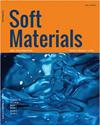载臭草水凝胶的制备及电位对伤口愈合中总黄酮释放行为的影响
IF 1.4
4区 材料科学
Q4 MATERIALS SCIENCE, MULTIDISCIPLINARY
引用次数: 0
摘要
摘要以暹罗草粗提物为原料制备明胶水凝胶,研究其形态、溶胀率、无外加电压刺激和有外加电压刺激体系下总黄酮释放量及抗菌性能。水凝胶的孔隙面积与横截面积之比为23.56%。水凝胶的溶胀率高达1087.32±16.16%。在没有外部电压刺激和有外部电压刺激的情况下,黄酮类化合物的总释放量随着时间的推移而增加。与无外部电压刺激的体系相比,有外部电压刺激的体系释放的总黄酮含量更多,释放速度更快。当刺激电压为0 ~ 0.3 V时,总黄酮当量有增加的趋势,当刺激电压大于0.3 V时,总黄酮当量减少。特定电压刺激可部分控制水凝胶中总黄酮的优选释放量。制备的水凝胶不仅具有极好的吸水特性,而且具有良好的革兰氏阳性细菌生长抑制作用,是治疗某些感染伤口的理想材料,具有新颖而良好的创面愈合材料和创面护理应用。本文章由计算机程序翻译,如有差异,请以英文原文为准。
Preparation of Chromolaena odorata (Siam weed) loaded hydrogels and the effect of electrical potentials on the total flavonoids releasing behavior for wound healing application
ABSTRACT Gelatin hydrogels containing the Chromolaena odorata (Siam Weed) crude extract were fabricated to study the morphology, the percentage of swelling, the total flavonoids released under a system without and with the external voltage stimulation, and the antibacterial properties. The percentage of pore area per cross-sectional area of the hydrogel was 23.56%. The hydrogels showed the extraordinarily high swelling percentage of 1,087.32 ± 16.16%. The total released flavonoids increased over time for both the systems without and with the external voltage stimulation. The total released flavonoid content from the systems with the external voltage stimulation was in larger quantities and more rapidly release comparing to the system in the absence of external voltage stimulation. The equivalent amount of the total released flavonoid tended to increase with the stimulating voltage of 0–0.3 V, but decreased when the excitation voltage was more than 0.3 V. Preferred amount of the total flavonoids released from hydrogels could be partly controlled by specific voltage stimulation. The fabricated hydrogel exhibits novel and great initial properties for wound healing materials and wound care application not only due to its extremely water absorption characteristic, but also perfectly in Gram-positive bacteria growth inhibition, which is ideal for the treatment of certain wounds with infection.
求助全文
通过发布文献求助,成功后即可免费获取论文全文。
去求助
来源期刊

Soft Materials
工程技术-材料科学:综合
CiteScore
2.90
自引率
0.00%
发文量
21
审稿时长
2.2 months
期刊介绍:
Providing a common forum for all soft matter scientists, Soft Materials covers theory, simulation, and experimental research in this rapidly expanding and interdisciplinary field. As soft materials are often at the heart of modern technologies, soft matter science has implications and applications in many areas ranging from biology to engineering.
Unlike many journals which focus primarily on individual classes of materials or particular applications, Soft Materials draw on all physical, chemical, materials science, and biological aspects of soft matter. Featured topics include polymers, biomacromolecules, colloids, membranes, Langmuir-Blodgett films, liquid crystals, granular matter, soft interfaces, complex fluids, surfactants, gels, nanomaterials, self-organization, supramolecular science, molecular recognition, soft glasses, amphiphiles, foams, and active matter.
Truly international in scope, Soft Materials contains original research, invited reviews, in-depth technical tutorials, and book reviews.
 求助内容:
求助内容: 应助结果提醒方式:
应助结果提醒方式:


